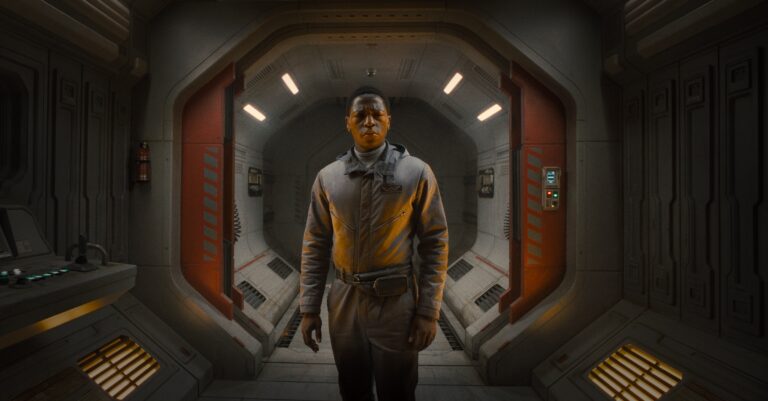Alien: Romulus (2024 | USA | 119 minutes | Fede Alvarez)
Sci-fi horror masterpiece Alien taught us that in space no one can hear you scream. The people in the theater with me for a preview screening of the latest entry in the metamorphic franchise were not so lucky. Helmed by Uruguayan horror director Fede Alvarez (Evil Dead, Don’t Breathe), Alien: Romulus throws a cast of capable young actors into the terrifying milieu of face-huggers, chest-bursters, and xenomorphs via a series of very poor choices. Set between Ridley Scott’s original Alien and James Cameron’s towering sequel Aliens, the latest entry is at best a minor footnote in the Alien mythology. I expect its deficiencies on that front might get in the way of some purists’ enjoyment of it as pure adrenaline rush. For me — an agnostic enjoyer of the decades of mythology — it was incredibly effective horror movie set in the inky blackness of space, with fresh terrors, unsettling images, and pulse-pounding sequences at every turn. It left me on edge for hours after seeing it, probably the scariest movie I’ll allow myself to see this year.
The film opens on a dismal mining colony, a planet sixty-five light years from Earth, plunged in permanent darkness. Run by the soulless Weyland-Yutani bureaucracy — instantly recognizable by the brutalist architecture — life there is a grim cycle of punishing, perpetually extended indentured servitude. It’s a world beset by advanced technologies yet so indifferent to human life that it relies on canary-toting laborers to toil below ground in jobs that will drive them to early graves. No wonder that Rain (Cailee Spaeny), an orphan who dreams of seeing the sun, and her small group of friends are so eager to escape that they’re willing to entertain the very dangerous plan of stealing a clunky space ship from their corporate overlords to steal some cryo-pods from an abandoned research station that’s drifted into the planet’s orbit so that they can take a deep sleep while hurtling across the galaxy to a new colony. A bad long shot plan is better than the certainty of a terrible life.
Rain’s boyfriend Tyler (Archie Renaux) and his brash asshole of a best friend (Spike Fearn) have hatched a scheme, but the key to getting off the ground is her android “brother” Andy. David Jonsson (marvelous in the underseen Hulu romcom Rye Lane and Max-sexy stockbroker series Industry) proves himself worthy as a compelling addition to the franchise’s pantheon of memorable synthetics (“we prefer the term artificial person”). Here, he’s a caretaker to Rain, programmed by their father to tell dad jokes with the prime directive of always doing what’s best for her. 1 But more importantly, he’s the key to getting through a bunch of locked doors and has to come along for the ride. When we first meet the character, he’s one of droll sentiment and limited intelligence. Later, Jonsson gets to flex as his programming gets some upgrades, making his performance the most compelling and impressive in the film.
Alvarez doesn’t dawdle on the planet or with the setup. Quickly, he has his band of young desperate strivers (Aileen Wu joins as tech-savvy pilot; Isabela Merced is along for the ride as Tyler’s sister) rocketing off into orbit. Aside from Rain and Andy, they’re all competent, but never establish themselves as much more than future Xenomorph chow. The boys plod onto the abandoned research station and stumble into all manner of unforeseen challenges while grainy live-streaming back to the spaceship (content creators survive into the future). Evoking H.R. Geiger’s iconic designs, there are ominous science labs, cavernous industrial bays, vertiginous elevator shafts, narrow corridors, and a fair share of incongruously unsettling classical artworks.
A brief prologue showed us what happened between the start of Sigourney Weaver’s deep sleep at the end of Alien and the beginning of this movie, so we have hints at what terrors lie ahead: menacing swarms of skittering crablike “facehuggers” in hot pursuit through airlocks, slimy little baby critters bursting through chests, and the main attraction, menacing sharp-toothed apex predator “xenomorphs” lingering around every dark corner to pounce, skewer with spiked tails, and hunt its prey. In that way it relies on playing in an IP sandbox where the audience has seen these movies. This puts us a step ahead of these brash but hapless kids as we know all of the unsettling creatures, ferocious monsters, and glistening horrors await.
In so many ways the movie is more a remix or tribute than anything deeply original, but there’s something instantly transporting and effective in anticipating the horrors and long minuscule odds. The production is one of dazzling practical effects and actual set design that instantly evokes its predecessors in appearance and tone. However, amid these rightfully celebrated tactile creations is a prickly choice, one that inadvertently echoes the core antagonist of each movie being being a merciless conglomerate’s obsession with progress without concern for the consequences to humanity. Here it’s the use of AI to resurrect an actor for a coldly villainous role: the likeness of Ian Holm grafted into service as another version of the android science officer he played in the original. I don’t know the particulars of how this digital reprisal came to be, but given the core concerns of last year’s SAG strike, a dead actor being resurrected onto a slightly new role is sure to be divisive.
Candidly, I was having far too much fun with the film’s costume party remix aesthetic to concern myself with whether it was more tribute or an atrocity. My minor complaint is how this character’s unrelenting prominence as an uncomplicated villain flattens the conflict and sidelines far more interesting discussions that could’ve been had with Jonsson’s Andy. But alas, for me, it’s a minor quibble. I’m hardly a connoisseur of scary cinema, but this is easily my favorite style of horror movie. Without being pedantic, Alvarez establishes a straightforward mission, sets up the rules, establishes a ticking clock, and then lets the consequences unfold with ruthless efficiency. As challenges mount, decisions get more chaotic, but the film doesn’t require the characters to make obviously dumb choices. The plot and backstory get slightly more convoluted, but everyone’s operating within a legible framework, albeit one that doesn’t care about their sloppy human emotions. It’s a relentless machine of ever-escalating intensity that gets grosser, scarier and more terrifying as it races with lean efficiency toward its unsettling and satisfying endgame.
Alvarez might be updating the famous shots of his more accomplished predecessors with new faces, but I can’t deny that they look incredibly cool. Although many of the setups directly evoke admittedly better movies, Spaeny and Jonsson carve out their own (minor) places in a pantheon of icons. She brings a vulnerability to the role of final girl with a big gun and growing determination to make it out alive, He’s a fascinating spin on a caring android working within complicated programming. Together, they’re the messy heart of the movie. Alvarez brings suitable deeply seated anatomical terrors to the creature design, finding increasingly disgusting new tricks in his bag to induce fresh squirms and frights. As he hurtles confidently toward a climax, some of the space stuff might leave Neil deGrasse Tyson apoplectic, but the rest of us delightfully breathless and jittery.
Alien: Romulus arrives in theaters on August 16th
Image via 20th Century Studios.
- Although Ridley Scott has said that his fever-dream of a TV show Raised by Wolves doesn’t share a universe or continuity with Alien, it’s hard not to see echoes of Abubakar Salim’s spandex-clad caretaker “Father” in Andy.



